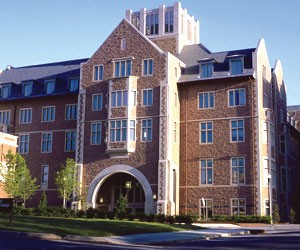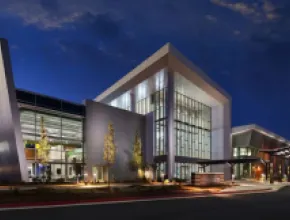Gone are the days of dorm rooms and classroom-style meeting rooms. Today’s university conference centers offer facilities that can rival traditional conference centers, with first-rate accommodations, the latest in technology, often a beautiful setting and competitive prices. And they’re growing in number.
“Most new conference centers today are university centers. It looks like it’ll be that way for the next few years,” says Dave Arnold, co-president and chief executive officer-East of Colliers PKF Consulting.
“It’s almost impossible to finance a corporate conference center these days,” he continues. “University conference centers have more opportunities for funding sources. The pressure to make money in university centers isn’t quite the same as in commercial conference centers. They have a higher mission to support activities on campus than a typical conference center would have.”
More and more colleges are answering that mission with plans for new centers. Ohio’s Kent State University broke ground in September on the Kent State University Hotel and Conference Center, which is slated to open in spring 2013. The $15 million project will have 95 rooms and 5,400 square feet of meeting space.
“The target market for the much-needed facility will be a mix of academic and business clients,” says Gene Finn, executive director of the Kent State University Foundation. “Two major companies are moving their headquarters to new facilities located across the street from the hotel and conference center and have already made inquiries into availability of the conference facilities. We also expect numerous Kent State academic departments to use the conference facilities as well, hosting national conferences on academic issues.”PageBreak
In January, Washington State University announced plans for a hotel and conference center on a site adjacent to the campus, located in Pullman. It will be the area’s first conference center in a hotel setting. Another project, a 250-room hotel and conference center at UCLA, was announced in November. The center, estimated to cost $212 million, will be funded by a private donor and bonds. The project must first be approved by the UC Board of Regents and, if approved, construction will begin in mid-2013 and be completed by early 2016.
Meanwhile, upgrades are taking place at the Marcum Conference Center and Miami Inn, at Miami University of Ohio. The facility is decreasing from two buildings to one and reducing its room count from 90 rooms to 50.
“Our rooms have not been renovated in about 20 years and they were looking very dated,” says Amy Poppel, director of conference & hospitality services. “The decor was very colonial—it’s a copy of an academic building at William and Mary. We’re going to a very traditional contemporary feel that fits our clients better.”
The project will be completed in June, and the center is operating throughout the renovation.
These upcoming and upgraded conference centers—and others like it across the nation—will give planners more options outside of standard hotel venues.
“University conference centers tend to be very technologically advanced,” says Tom Bolman, executive vice president of IACC. “They often are a little bit less expensive than other conference centers, but they are built to an executive standard. They also have a lot of resources on campus that planners can use. Professors can serve as speakers. Students can be brought in as focus groups.”
University conference center executives and planners who have worked with these facilities agree that these venues can compete successfully in the market.
Charles F. Knight Executive Education and Conference Center, on the campus of Washington University in St. Louis, is a great example of that. With 66 guest rooms and meeting space for groups that average 35 to 50 people, the center hosts about 3,200 meetings each year.
“Since we’re on a university campus, about 60 percent of our business comes from the school, with the rest from corporate and association groups,” says Bryan Mueller, director of sales. “Our AV is top notch. There’s nothing that we can’t do here.”
There’s also a department at Wash. U where planners can go to find professors, if they want to use the instructors for their programs, he notes.
Concerns voiced by planners revolve around accommodations and location.
“People at first thought we have dorm-style rooms, but we have as nice a room as any flagged hotel in the city,” he says. “Parking is always a concern, but we have a dedicated parking garage.”
Mara Christensen, director of sales and marketing for the University Inn and Conference Center, at Utah State University in Logan, Utah, faces some of the same concerns, which are for the most part unwarranted. The benefits of university venues are many, she says, including a pricing level that may not be available elsewhere.
“There is a community within a community and it’s an enlightening, stimulating environment,” she says. “There are a lot of open areas and unique places to host functions. We can often team up with other venues on campus for after-hours events and have state-of-the-art space for music, theater and opera.”
The University Inn and Conference Center includes 74 guest rooms, 9,000 square feet of meeting space and a 400-seat auditorium. Like six other centers across the country, University Inn is funded by the W.K. Kellogg Foundation. It hosts government, military and educational conferences but most of the business is from associations related to university research.PageBreak
The fact that it is a university venue means it offers a range of accommodation levels that would be difficult to find in other venues.
“With a lot of academic conferences you have everything from professors who can afford a hotel room to students who are packing 10 to a room so they can afford it. To be able to offer a dorm room at $18 per night (during summer months and vacation times) can be attractive,” Christensen says.
Another advantage of working with university conference centers is the enthusiasm and dedication of the on-site planners, according to Miami University’s Poppel.
“University planners will go above and beyond what it takes to make things happen. They are very flexible and come up with a lot of resources to add to an event,” she says. “Our university president even has given keynote addresses to a few of our groups.”
The center also offers an excellent learning environment for training programs, according to Katie Maciag, owner and president of Planners Network in Cincinnati, who has held programs at Miami University’s Marcum for more than 20 years.
“Besides providing an instant connection with education, it provides an opportunity to get away from the typical venue,” she says.
While most conference centers are on large campuses, a few smaller universities also have them. One of these is DePauw University, in Greencastle, Ind., where the Inn at DePauw & Event Center hosts everything from legal and insurance meetings to a twice-yearly scrapbooking conference. The 54-room center has 2,500 square feet of meeting space.
“We do a lot of teaming up with DePauw for its lecture series’ and more,” says Lauren Smoot, director of sales. “President Clinton was here in November, so we contacted potentially interested people and said, ‘Come over, we can get tickets.’”
For some in-state groups, especially government-related, state universities hold appeal.
“Spending in the state stays in the state,” says Laura Elliott, sales manager for Kellogg West Conference Center and Hotel at Cal Poly Pomona. “Our per diem is within the L.A. County budget. A lot of state agencies use us, as do the unified school districts and a lot of corporate and association groups.”
Kellogg West, located east of Los Angeles, includes 85 guest rooms and 12,800 square feet of meeting space. It’s located on the old Kellogg Estate, on a hillside above campus, and provides the type of atmosphere many groups are seeking. Planners enjoy the center.
“We use the Pasadena Hilton and different Marriotts, but this location is quieter,” says Sharon Stillwell, office manager of the United Nurses Associations of California.
“We do a lot of training for our hospitals and have our annual conference, where all the hospitals come together,” she continues. “We go there rather than being in the office so we won’t be distracted.”
The center has easy access from all over Southern California and the parking is free, which is a plus for the area and another point in favor of university centers.
“I highly recommend holding meetings in—as well as utilizing—university conference centers,” Maciag says. “I think that they should be considered and not overlooked.”
Judy Jacobs, a freelance writer based in Moraga, Calif., has been writing for travel industry publications for over 20 years.






